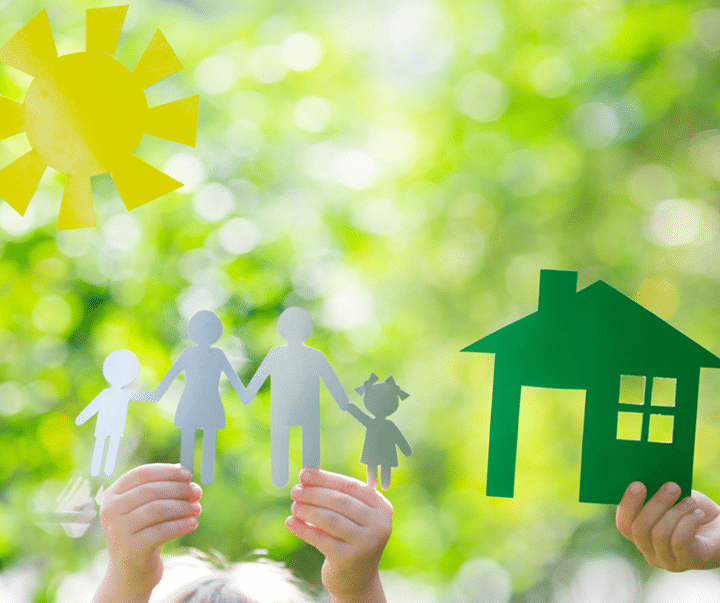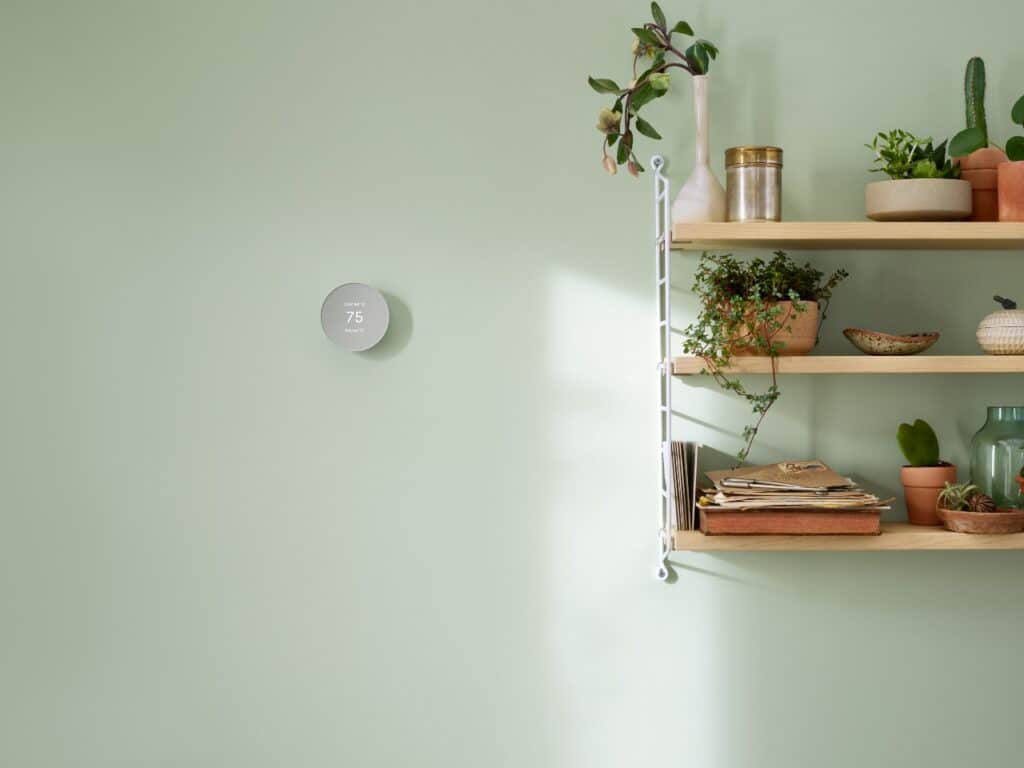Going green doesn’t have to cost a gazillion dollars. In fact, there are plenty of ways to lower your environmental impact without spending even a loonie! Some of these ideas could actually save you money. No excuses! It’s time to make a positive change.
From rooftop to basement, inside or out, here are our eight favourite ways to go green at home.
LED Lights
This one is a no-brainer. Energy Star®–certified LED lights use up to 90% less energy and last at least 15% longer than regular incandescent light bulbs1. As well as being more energy- and cost-efficient, LED bulbs also don’t contain mercury like some other bulbs do, and options abound for levels of brightness and light appearance, such as cool versus warm lighting (you know, work lighting compared to Netflix-and-chill ambiance). LED lights can be used in any room in your home and work well in both installed lighting, like kitchen pot lights and spot lighting fixtures, such as a reading bedside lamp.
Heat Pump
A heat pump is a heating and cooling unit that mechanically transfers heat to or from outside as it’s needed. In warmer months, a heat pump uses the same technology as an air conditioner, extracting heat from your home and pushing it outside. In colder seasons, it reverses the process, drawing available heat from the air or ground outside and pumping it inside. Book an appointment with a Home Comfort Advisor to determine your home’s individual needs and visit our Ultimate Air Conditioning Guide to learn more about heat pumps.
Solar Panel System
Solar panels used to be a luxury for only the most extravagant. These days, they’re more affordable and accessible and can be installed not just on roofs but in yards and fields where sunshine is prevalent. According to Environment Canada, “about half of Canada’s residential electricity requirements could be met by installing solar panels on the roofs of residential buildings2.” No matter where you live, solar panels could offer homeowners a way to contribute to the energy solution rather than the environment problem.
Green Kitchen Hacks
The kitchen could provide the most options for improving your carbon footprint and saving on energy costs at home — and with a range of financial investment. Those on a tight budget may want to focus first on composting, which diverts organic matter from the landfill and can be used as fertilizer. Win-win! Being conscientious of how you use your refrigerator is another freebie way to go green. Your fridge and freezer should be full (not stuffed), and keep coils dust-free. Batch-cooking, which involves making extra portions, and one-pot meals — chilli, anyone? — cut down on how often you use your big kitchen appliances, saving energy and reducing costs. Following the reduce, reuse and recycle mantra, focus on avoiding unnecessary food packaging when possible and choose products packaged in reusable containers. Or consider investing in reusable storage containers, such as beeswax wraps and sturdy, dishwasher-safe metal tins. When it’s time to replace or invest in a new dishwasher, opt for an energy-efficient appliance, which costs more up front but can save you money (and save our water) in the long run!
Insulation
Insulation helps your home retain heat in the cooler months and cooled air in the warmer seasons. This could reduce the cost of heating and cooling and improve your home’s overall value. For decades, fibreglass insulation has been the standard for new homes. These days, there are many green insulation options, too — like aerogel, cellulose, cotton denim, polystyrene, ThermaCork and sheep’s wool.

Reliance™ Carbon Offset Program
No Canadian home can escape the need for heat at some point over the course of a year! Ice in your pipes? Butter that won’t spread? No thanks. Because we can’t avoid our need for heat, we are, in essence, contributing to Earth’s greenhouse gas problem. To offset the damage, we can opt-in to a carbon-offset program, like the one offered by Reliance. Renting SmartAir™ Green Series affords homeowners the chance to buy carbon credits about equal to the greenhouse gas emissions those natural gas products produce. These funds provide critical direct funding to support the development of environmentally friendly technologies emissions reduction.
Tankless Water Heater
There are a ton of aliases for tankless water heaters —on-demand, continuous flow, instantaneous and inline heaters — but they all do one simple thing: they essentially use a heat-exchanger coil to heat water as it flows through the device. Besides being a big space-saver, the huge bonus for this kind of water heater is that you never run out of hot water! (Psst, families with bathroom-hogging teens and mud-loving dogs.) Compared to storage water heaters, a tankless water heater doesn’t waste energy with standby heat loss since water never becomes tepid while sitting in a tank, needing to be reheated. And because water heating is usually the second-largest utility expense, according to National Resources Canada3 , this could have a noticeable impact on your wallet and, just as important, the environment. As long as the teens don’t have hour-long showers, that is. Learn more about Tankless Water Heaters.

Smart Home
Smartphones have revolutionized the way we live, work, exercise and socialize. Now it’s time to embrace the functionalities of smart home technologies to both save dollars and lighten our burden on the environment. As you might already know, home automation, also called domotics (a hybrid word blending “domus,” Latin for “home,” and “robotics”), basically gives you the ability to access the devices in your home from any place that is connected to the internet so that you can control things like temperature, security, lighting, appliances and entertainment systems touch-free. It’s like a modern-day version of the Clapper! A smart home could lower your energy costs and environmental footprint by controlling your appliances and electronics more efficiently than you do. Don’t be insulted. A smart home thermstat, for example, could help your home consume less energy for heat when you’re out and about or when you’re sleeping. Visit our Ultimate Smart Home Guide, then book a free in-home consultation with a Reliance Smart Home Advisor for more information.

Be sure to check out all the available rebates for Heat Pumps available in your area here.
Smart home is only available in select regions.
The ENERGY STAR® name and symbol are administered and promoted in Canada by Natural Resources Canada and are registered in Canada by the United States Environmental Protection Agency.
1Natural Resources Canada
2Natural Resources Canada
3Natural Resources Canada








